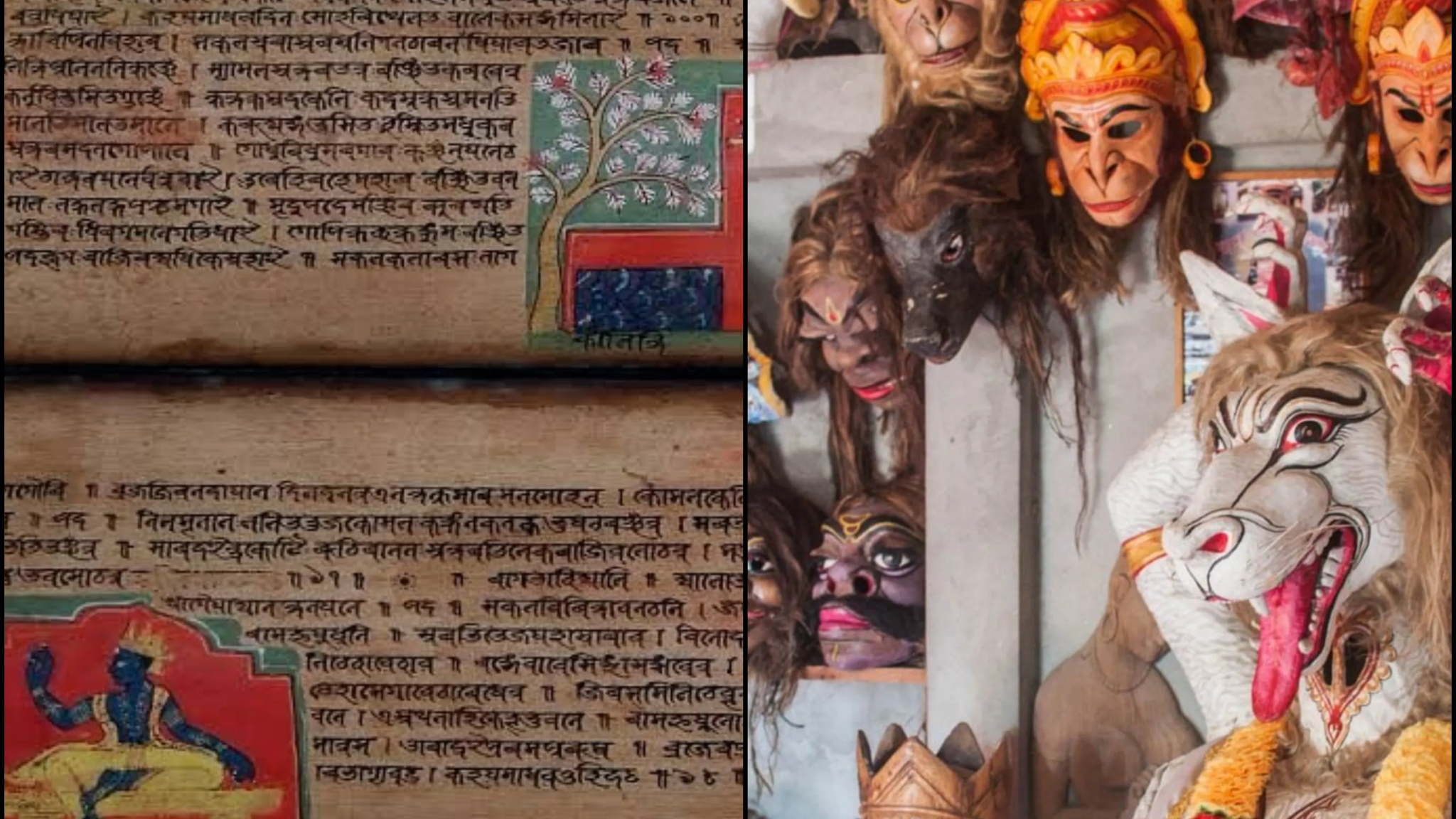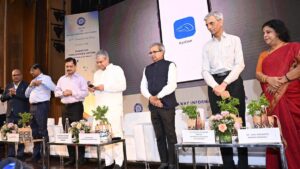Table of Contents
LCA Tejas
Context: A Tejas aircraft of the Indian Air Force crashed at Jaisalmer during an operational training sortie.
About Light Combat Aircraft- Tejas
- About: The Tejas (which means “Radiance” in Sanskrit) is an Indian single-engine, delta-wing, light multirole fighter.
- Designed by: the Aeronautical Development Agency (ADA) (DRDO) in collaboration with the Aircraft Research and Design Centre (ARDC) of Hindustan Aeronautics Limited (HAL), it serves both the Indian Air Force (IAF) and the Indian Navy.
- Commissioned: The Tejas program was envisioned in the late 1980s to replace the ageing MiG-21 aircraft that had been serving the IAF since 1963.
- Key Facts about Tejas:
- Generations: Tejas is a 4.5-generation multi-role fighter aircraft.
- Variants: It comes in a single-seater version (for the IAF) and a twin-seat trainer variant (used by both the IAF and the Indian Navy).
- Lightweight: Tejas is the smallest and lightest aircraft in its class, thanks to extensive use of composite materials.
- Order and Replacement: The IAF currently operates 40 Tejas MK-1 aircraft, and an additional 83 Tejas MK-1A fighters are on order (worth ₹36,468 crore). The plan is to replace the ageing MiG-21s with the Tejas Mark 1A by 2025.
- Performance Comparison:
- Speed: Tejas has a top speed of Mach 1.6 to 1.8.
- Payload: Its maximum external load capacity is 7,700 pounds.
- Service Ceiling: Tejas can operate at an impressive altitude of 52,000 feet.
- Global Context: While Tejas performs well, it remains unexceptional compared to top-performing fourth-generation light fighters like the F-163.
- Why Tejas Stands Out:
- Lightness: Compared to the Sukhoi series, Tejas is much lighter.
- Carrying Capacity: Tejas is fully capable of carrying a load of eight to nine tonnes.
India-Top arms Importer – 2019-2023
Context: According to Swedish think tank Stockholm International Peace Research Institute (SIPRI), India was the top arms importer in the world in the period 2019-23, with imports having gone up by 4.7% compared with the period 2014-18.
Other Findings of the Report
- Russia’s Role for India: Despite Russia remaining India’s primary arms supplier, accounting for 36% of its imports, this period marked the first time since 1960-64 that Russia (or the Soviet Union before 1991) constituted less than half of India’s arms imports.
- India’s Defence Budget: For the 2024-25 fiscal year, India’s Defence Ministry was allocated ₹6.2 lakh crore, with ₹1.72 lakh crore designated for new procurements, marking a 5.78% increase from the previous year’s budget estimates.
Global
- Major Arms Importers: Nine out of the ten biggest arms importers during this period, including India, Saudi Arabia, and Qatar, were located in Asia, Oceania, or West Asia, with Ukraine emerging as the fourth largest following major arms transfers in 2022-23.
- Increase in European Arms Imports: European countries saw a 94% surge in arms imports between 2014-18 and 2019-23, largely influenced by the conflict in Ukraine.
- Pakistan’s Imports: Pakistan, the fifth largest arms importer, saw a 43% increase in imports, with China supplying 82% of its arms.
- Global Arms Exports: The U.S. saw a 17% growth in arms exports, while Russia’s exports fell by more than half.
- France became the second largest arms supplier globally, with a 47% increase in its exports.
- European Imports and Exports: Over half (55%) of European arms imports came from the U.S., an increase from 35% in the previous period.
- Europe accounts for about a third of the world’s arms exports, showcasing its significant military-industrial capacity.
- France’s Exports: 42% of France’s arms exports were to Asia and Oceania, and 34% to West Asia, with India being the largest recipient (nearly 30%)—mostly due to combat aircraft deliveries to India, Qatar, and Egypt.
- Future European Imports: With nearly 800 combat aircraft and helicopters on order, European arms imports are expected to remain high, reflecting continued demand for high-value military equipment.
Marketing Code for Pharma Firms
Context: The Department of Pharmaceuticals released the Uniform Code for Pharmaceutical Marketing Practices (UCPMP), 2024, outlining ethical marketing regulations for pharmaceutical companies.
Rules on Drug Promotion and Representation
- Use of “Safe” and “New”: Restrictions are placed on using the terms “safe” and “new” for drugs.
- “Safe” must not be used without qualification, and “new” cannot describe drugs or therapies available/promoted in India for over a year.
- Marketing Approval Consistency: Drug promotions must align with the drug’s marketing approval conditions.
- Prohibition on Pre-Approval Promotion: Drugs cannot be promoted before receiving marketing approval from the competent authority.
- Evidence-Based Claims: Claims regarding a drug’s usefulness must be supported by the latest evidence, avoiding absolute safety or no side effects/risk claims.
Interactions with Healthcare Professionals
- No Inducements for Interviews: Medical representatives are prohibited from using inducements or subterfuge to secure interviews with healthcare professionals.
- Prohibition on Payments for Access: Direct payment or under any guise for access to healthcare professionals is forbidden.
- Guidelines for Continuing Medical Education (CME): Engagement with healthcare professionals for CME must follow transparent, verifiable guidelines, excluding events in foreign locations.
Gifting and Monetary Grants
- Gifting Prohibition: Pharmaceutical companies and their agents (distributors, wholesalers, etc.) are banned from gifting to healthcare professionals and their families.
- No Cash or Monetary Grants: Offering cash or monetary grants to healthcare professionals or their families is strictly prohibited.
- Ban on Pecuniary Advantages: Offering, supplying, or promising any pecuniary advantage or benefit in kind to those qualified to prescribe or supply drugs is not allowed.
Compliance and Enforcement
- Mandatory Compliance: The UCPMP 2024 is circulated for strict adherence by all relevant parties in the pharmaceutical sector.
We’re now on WhatsApp. Click to Join
GI Tag for Majuli Masks
Context: Traditional Majuli masks & Majuli manuscript painting in Assam were given a Geographical Indication (GI) tag by the Centre.
Majuli Masks of Assam: An Overview

Majuli Island
- World’s Largest River Island: Majuli is recognized as the largest river island globally.
- Cultural Hub: It stands as a central location for Assam’s neo-Vaishnavite tradition.
- Historical Artistry: The island has hosted the craft of mask-making since the 16th century.
- Evolution of Practice: Traditional practitioners are now expanding the art from sattras (monasteries) to broader contexts.
Nature of Majuli Masks
- Craftsmanship: Majuli masks are crafted by hand, specifically for use in bhaonas (theatrical performances) on the island.
- Cultural Performances: Bhaonas carry devotional messages, rooted in the neo-Vaishnavite tradition, initiated by reformer saint Srimanta Sankardeva.
- Role in Performances: These masks bring to life various characters in devotional narratives.
Characteristics of Majuli Masks
- Diverse Depictions: Masks represent a range of figures, including gods, demons, and mythical creatures like Ravana, Garuda, and Hanuman.
- Variability in Size: Sizes vary from face-only masks (mukhmukha) to full body and head coverings (chomukha), requiring five days to one-and-a-half months to create.
- Materials: Created using local resources such as bamboo, clay, dung, cloth, cotton, and wood.
Monastic Tradition and Mask-Making
- Sattras: Majuli is home to 22 sattras, with four primarily engaged in mask-making: Samaguri Sattra, Natun Samaguri Sattra, Bihimpur Sattra, and Alengi Narasimha Sattra.
- Foundation of Sattras: Established by Srimanta Sankardev and his disciples, sattras serve as centers for religious, social, and cultural reforms.
- Arts in Sattras: These institutions also nurture traditional performing arts like borgeet (songs), xattriya (dance), and bhaona (theatre), integral to the Sankardev tradition.
Majuli Manuscript Painting
- Origins: Majuli manuscript painting, a tradition dating back to the 16th century, involves creating artwork on manuscripts.
- Material: These paintings are crafted on sanchi pat, which are manuscripts made from the bark of the sanchi or agar tree.
- Ink: Artists use homemade ink for the paintings, adhering to traditional practices.
- Historical Example: The earliest known illustrated manuscript is the Adya Dasama of the Bhagwat Purana in Assamese, rendered by Srimanta Sankardev.
- Royal Patronage: The art form was supported and patronised by the Ahom kings, enhancing its significance and preservation.
- Continued Tradition: Manuscript painting is still actively practised within every sattra (monastic center) on Majuli Island.


 RailOne App: Indian Railways Launches Al...
RailOne App: Indian Railways Launches Al...
 Special Intensive Revision (SIR) of Elec...
Special Intensive Revision (SIR) of Elec...
 Daily Quiz 01 July 2025
Daily Quiz 01 July 2025





















